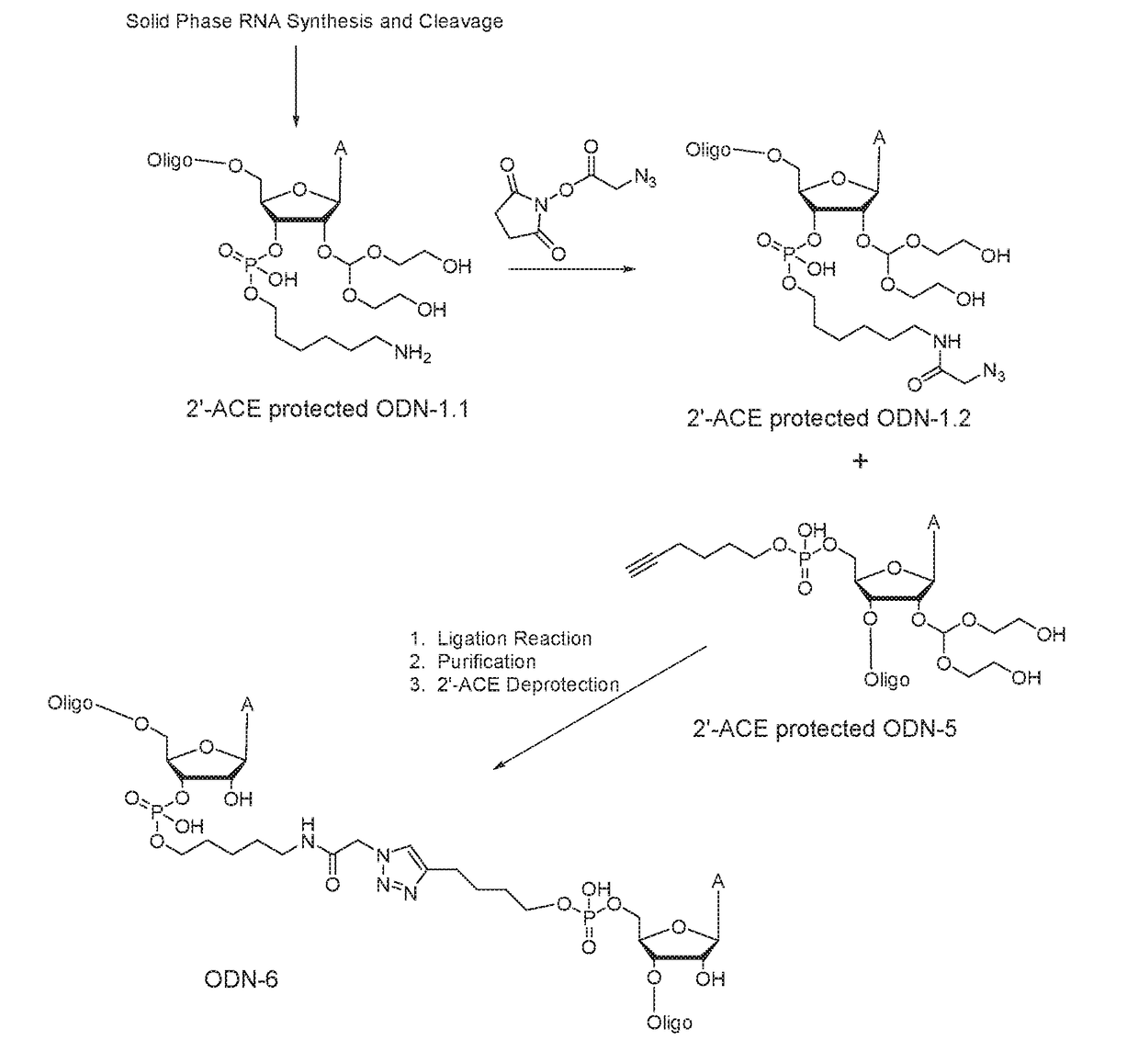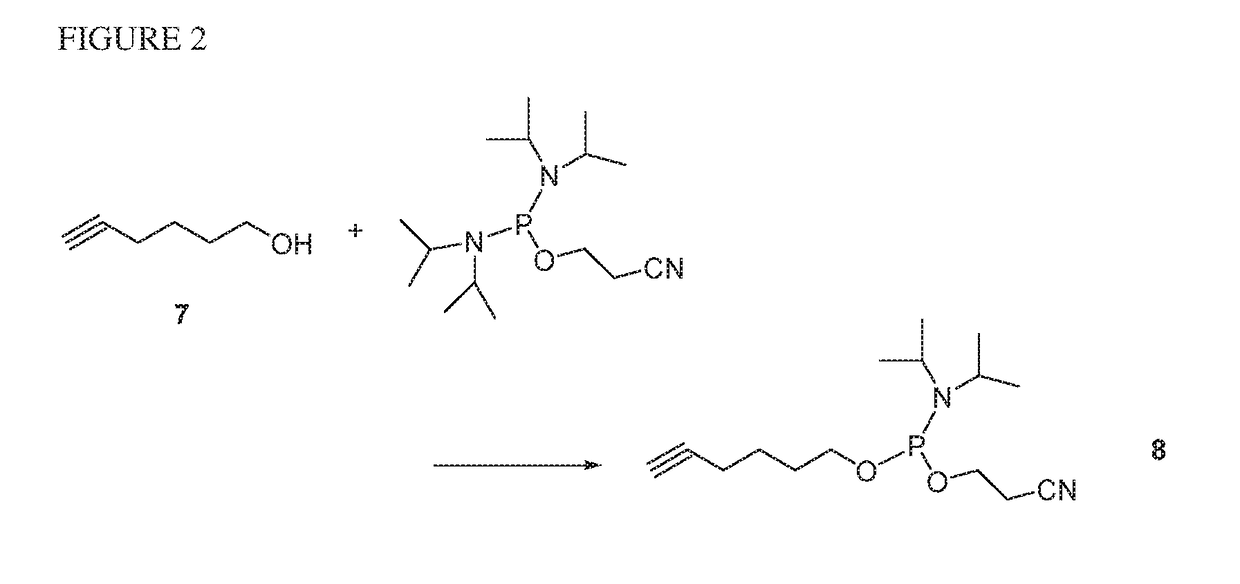Synthetic single guide RNA for cas9-mediated gene editing
- Summary
- Abstract
- Description
- Claims
- Application Information
AI Technical Summary
Benefits of technology
Problems solved by technology
Method used
Image
Examples
example 1
Preparation of 3′-azidoadenosine polystyrene Support (FIG. 1)
1
[0067]N6-Isobutyryl 2′O-[2(2 hydroxyethyl)methylcarbamate]-3′,5′-O-(tetraisopropyl-disiloxane-1,3-diyl)adenosine (2)
[0068]To a solution of compound 1 (10.0 g, 17.2 mmol) in 170 mL of dichloromethane (DCM) was added CDI (1,1′-carbonyldiimidazole) (2.9 g, 18.1 mmol). After 18 h of stirring, 2-(methylamino)ethanol (5.2 g, 68.8 mmol) was added. The reaction was stopped after 1.5 h and evaporated to dryness. The crude material was purified on a Biotage Isolera using a 100 g Ultra cartridge with an ethyl acetate:MeOH gradient (0→10%) to give 2 (10.8 g, 93%) as a white foam. Compound 2 was analyzed by RP-HPLC: 10.54 min, 99.4%. 1H NMR (CDCl3, 300 mHz) δ8.65 (s, 1 H), 8.63 (s, 1 H), 8.10 (s, 1 H), 6.04 (d, J=8.8 Hz, 1 H), 5.64 (d, J=5.3 Hz, 1 H), 5.15 (m, 1 H), 4.16-3.98 (m, 4 H), 3.76 (m, 2 H), 3.56-3.15 (m, 3 H), 3.05 and 2.96 (each as s, 3 H), 2.86 (s, 1 H), 2.59 (m, 1 H), 1.27 (d, J=6.8 Hz, 6 H), 1.08-1.01 (m, 28 H).
N6-Isobut...
example 2
Preparation of 5′-hexyne phosphoramidite (8) (FIG. 2)
[0075]Compound 7 (hex-5-yn-1-ol, 1.4 mL) was dissolved with 10 mL DCM in a flask and N,N-diisopropylamine (1.82 mL) was added to the solution. In a separate flask under anhydrous conditions, the phosphinylating reagent bis-(N,N-diisopropylamino)-cyanoethylphosphine (1.5 equiv per equiv 7) was diluted with DCM (2 mL per mmol phosphine) and a solution of 0.45 M 1H-tetrazole in MeCN (0.5 equiv tetrazole per equiv 7) was added and shaken for 5 min. Next, the solution of activated phosphinylating reagent was added to the well-stirred solution of compound 7 at room temperature and stirred at room temperature until the reaction is complete by TLC analysis. To quench the excess phosphine ethanol was added and the reaction mixture was stirred for additional 30 minutes and dried on the rotary evaporator. The product was purified on silica gel to give 0.8 g of phosphoramidite 8. 31P NMR (CDCl3, 121.5 mHz) δ147.0 (s).
example 3
Conjugated Oligonucleotide Synthesis (Table 1 and FIG. 3)
[0076]2′-ACE protected RNA oligonucleotides (ODN-1.1, ODN-2, ODN-3.1, ODN-4, ODN-5, ODN-7, and ODN-8) were chemically synthesized on a MerMade synthesizer (Bioautomation Corporation, Irving, Tex..) using polystyrene solid supports and 2′-bis(acetoxyethoxy)-methyl ether (2′-ACE) phosphoramidites. For ODN-2 and ODN-4, aminomethylated polystyrene support 6 (see Example 1) was employed. For ODN-5, 5′-hexyne phosphoramidite 8 was used. After completion of synthesis cycles, the oligonucleotide on the support was treated with Na2S2 solution at room temperature followed by washing with water. The oligonucleotide was cleaved from the support with 40% of aqueous N-methylamine (NMA) and then heated at 55° C. followed by lyophilization to dryness. The crude RNA was desalted, purified by HPLC, and the identity of the purified sample was confirmed by UPLC and ESI-MS.
[0077]ODN-1.2 and ODN-3.2: Azidoacetic acid NHS ester (Click Chemistry Tool...
PUM
| Property | Measurement | Unit |
|---|---|---|
| Length | aaaaa | aaaaa |
Abstract
Description
Claims
Application Information
 Login to View More
Login to View More - R&D
- Intellectual Property
- Life Sciences
- Materials
- Tech Scout
- Unparalleled Data Quality
- Higher Quality Content
- 60% Fewer Hallucinations
Browse by: Latest US Patents, China's latest patents, Technical Efficacy Thesaurus, Application Domain, Technology Topic, Popular Technical Reports.
© 2025 PatSnap. All rights reserved.Legal|Privacy policy|Modern Slavery Act Transparency Statement|Sitemap|About US| Contact US: help@patsnap.com



